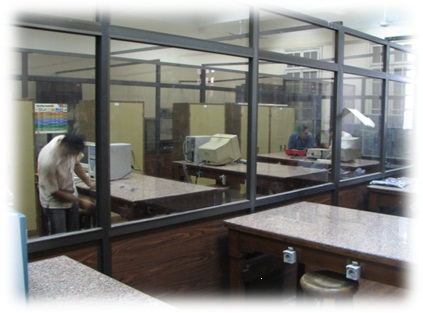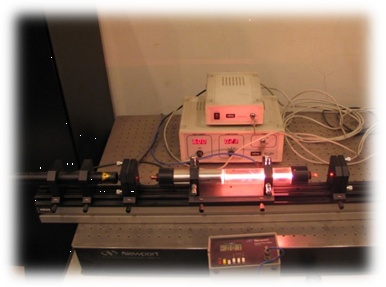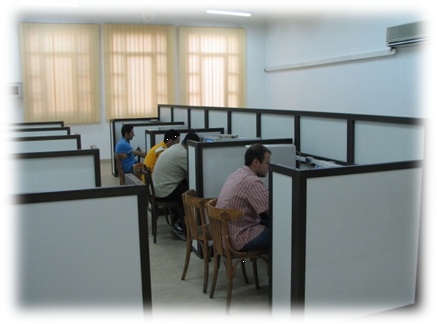Goals
2019 Version
The Electronics and Electrical Communications Engineering (EECE) Program aims at providing future engineers with appropriate theoretical knowledge and technical skills to respond to professional market demands, More specifically, the programs aims to:
-
Qualify students to understand system constituents, behavior and analysis in the following areas:
- Electronic Systems and Circuits.
- Communications Systems.
- Control Systems.
- Electronics and Communications of Computer Systems.
- Electromagnetic Waves Systems and Applications.
Upon the completion of studying the program the student should be capable to:
- Demonstrate knowledge and understanding of the fundamental electrical concepts
- Analyze and understand the behavior of any sophisticated electronic circuit or equipment
- Design state-of-the-art electronic and electrical communications systems
- Plan and implement applied research activities, evaluate outcomes and draw resaonable conclusions
- Communicate efficiently in various forms (written, verbal, ... , etc)
- Providing distinguished learning experience for students:
(Up-to-date knowledge – Useful Lab experience – Close interaction with Staff – Satisfactory Internet facilities – Access to E-Learning Courses – Availability of Licensed Educational Software - Soft skills development – Basic design experience)
- Supporting enhanced research opportunities for Staff:
(Adequate research spaces - Advanced research equipment – Qualified technical staff and assistants – Well-defined research plan - Joint research contracts with stakeholders – Support to acquire research grants)
- Encouraging continued development and upgrading of human capacities:
(Career development courses – ICT literacy – English language proficiency)
- Establishing plans for maintaining and upgrading physical facilities:
(Adequate audio-visual facilities – Renovation of lecture halls, labs and offices – Air conditioning in lecture halls, labs, and offices – Documentation of building drawings – Maintenance scheduling and documentation – Fire safety and hazard protection – Emergency exits and precautions – Elevator maintenance and upgrade)
- Developing modern information technology facilities to support program activities:
(Modern Local Area Network – High performance servers – Wireless Access Points – Comprehensive portal for the department – Open source E-Learning Management System – Reliable access to the Internet)
- Ensuring adequate and sustained financial resources:
(Donations from stakeholders – Income from financed projects – Income from training courses and workshops – Income from conferences –Contributions from alumni – Budget allocations by Faculty and University)
- Developing mechanisms for visibility and transparency:
(Well-designed departmental portal – Organizing conferences and workshops – Authoring books and e-courses by staff – Participating in university and government committees –Providing consultancy and technical advice – Close interaction with stakeholders – Strong relationship with alumni – Participating in student competitions – Publishing papers in prestigious journals and conferences)
- Targeting national and international recognition and accreditation.
2012 Version
The Electronics and Electrical Communications Engineering Program aims at providing future engineers with appropriate theoretical knowledge and technical skills to respond to professional market demands, The programs aims to:
-
Qualify students to understand system constituents, behavior and analysis in the following areas:
- Electronic Systems and Circuits.
- Communications Systems.
- Control Systems.
- Electronics and Communications of Computer Systems.
- Electromagnetic Waves Applications and Systems.
By the completion of the study the student will be capable to:
- Demonstrate knowledge and understanding of the fundamental electrical concepts
- Select one of the five disciplines mentioned above
- Analyze and understand the behavior of any sophisticated electronic circuit or device
- Design single electronic systems
- Plan and execute research work, evaluate outcomes and draw conclusions
- Communicate efficiently in written, verbal and other forms
- Providing distinguished learning experience for students:
(Up-to-date knowledge – Useful Lab experience – Close interaction with staff – Satisfactory Internet facilities – Access to E-Learning Courses – Availability of Licensed Educational Software - Soft skills development – Basic design experience)
- Supporting enhanced research opportunities for staff:
(Adequate research spaces - Advanced research equipment – Qualified technical staff and assistants – Well-defined research plan - Joint research contracts with stakeholders – Support to win research grants)
- Encouraging continued development and upgrading of human capacities:
(Career development courses – ICT literacy – English language proficiency)
- Establishing plans for maintaining and upgrading of physical facilities:
(Adequate audio-visual facilities – Renovation of lecture halls and labs – Air conditioning in lecture halls, labs, and offices – Documentation of building drawings – Maintenance scheduling and documentation – Fire safety and hazard protection – Emergency exits and precautions – Elevator maintenance and upgrade)
- Developing modern information technology facilities to support program activities:
(Modern Local Area Network – High performance servers – Wireless Access Points – Comprehensive portal for the department – Open source E-Learning Management System – Reliable access to the Internet)
- Ensuring adequate and sustained financial resources:
(Close relationship with High Tech Center – Donations from stakeholders – Income from financed projects – Income from training courses and workshops – Income from conferences –Contributions from alumni – Department share from Graduate Student Registration – Budget allocations by Faculty and University)
- Developing mechanisms for visibility and transparency:
(Well-designed departmental portal – Organizing conferences and workshops – Authoring books and e-courses by staff – Participating in university and government committees –Providing consultancy and technical advice – Close interaction with stakeholders – Strong relationship with alumni – Participating in student competitions – Publishing papers in highly placed journals and conferences)
- Targeting national and international recognition and accreditation.




